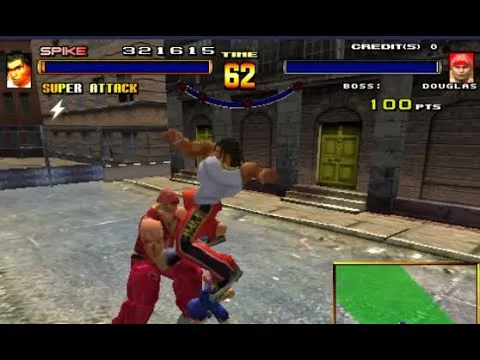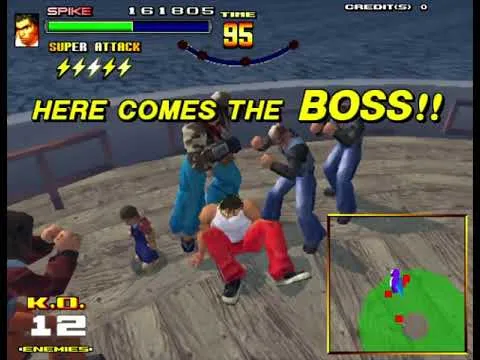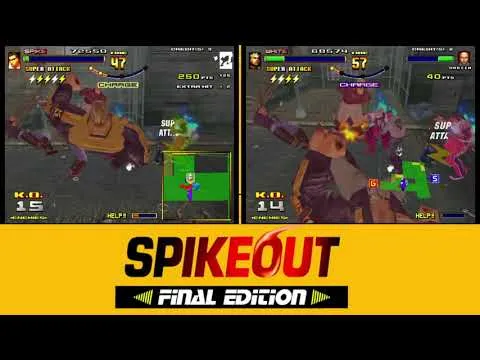

This may not be known to many, but while SEGA's Yakuza franchise has been one of its most successful modern franchises thanks to its story and world combined with a 3D beat-em-up fighting style, hardcore SEGA fans will know that the experience behind both aspects of the game has origins going back a few years.
On the one hand, Yu Suzuki had already experimented with a game with an explorable world and a focus on story and environment, along with a fighting system inspired by Virtua Fighter (a franchise he also created and directed until the fourth installment). This would be Shenmue.
On the other hand, Toshihiro Nagoshi, who worked with Yu Suzuki on several arcade racing games (such as Daytona USA 2 and F-ZERO GX) and was also the creator of Super Monkey Ball, also designed and produced a 3D action game...only it would be the counterpart with nothing but action (as opposed to exploration and story with a bit of action): SpikeOut.
...and 7 years later, he would produce the first Yakuza installment for PS2, in which he combined Suzuki's idea with Shenmue and its story with his own experience with 3D combat. But since I have yet to experience any of the games properly, I'm going to tell you about that adrenaline-filled predecessor: SpikeOut Final Edition.
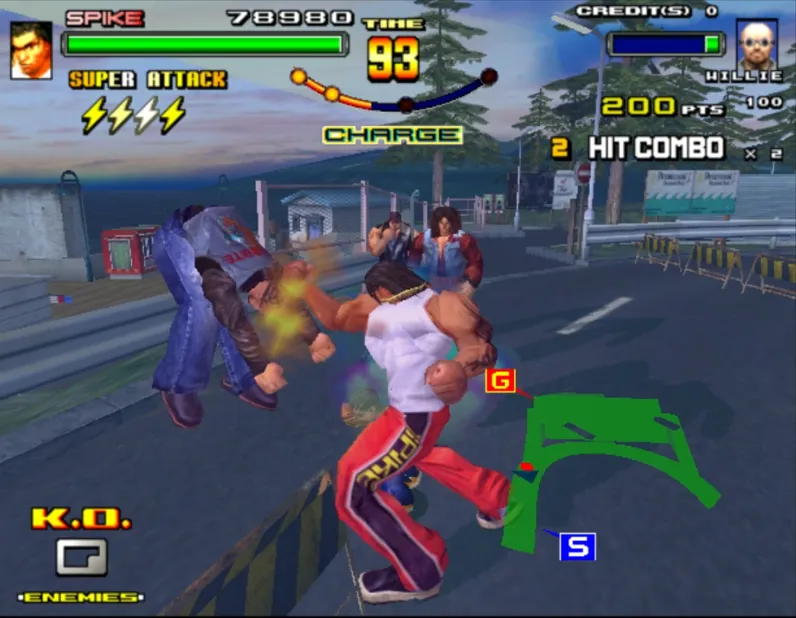
For starters, the main difference between "Final Edition" and the original "Digital Battle Online" is that this one includes a new first level (and the old one is played after completing this one), and another additional level...but other than that there's not much documented about the slightest differences. But most who are interested in Spikeout tend to play Final Edition.
With that said, this is a 3D beat-em-up reminiscent of games like Streets of Rage, but for its time (and even for today, if you don't count Hack and Slash which would be more similar to what was done here) it did it quite differently: The levels were divided into areas and several of them were not simple corridors, but places with obstacles and even elevation levels (like being on the first floor of a shopping mall while there are more enemies above), and the controls also had their own twist.
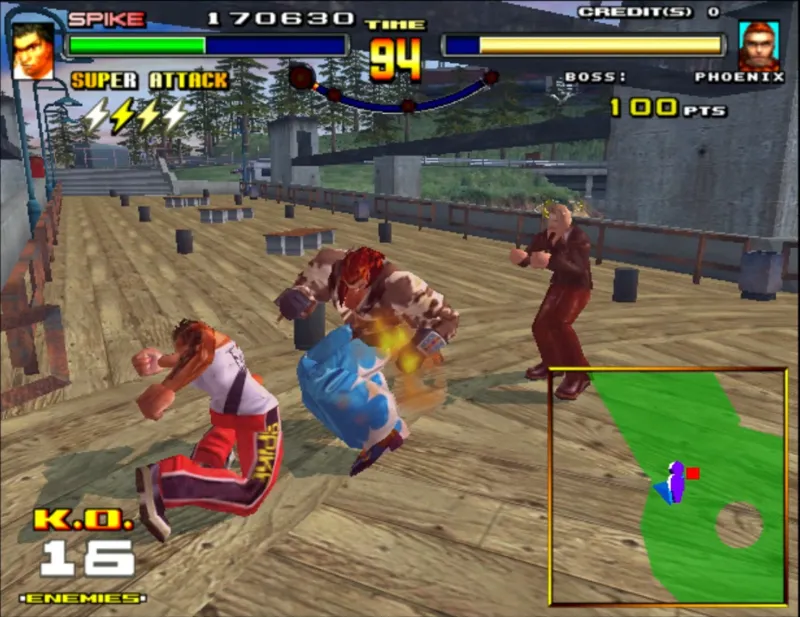
In addition to your mandatory hit and jump button, you have a button to move sideways without turning from where you're looking (which is useful for dodging enemies if someone comes running towards you and not losing sight of certain enemies) and a kick button that when held down turns into a charged attack while the charge bar increases. You have three charged attacks: A quick attack to send an enemy into the air at level 1, an attack that stuns your enemy with a punch to the stomach at level 2, and a powerful attack at level 3. To use the attack you want you have to press and release at the right moments to get the desired level, and you can't keep it charged forever.
The game gives you several options to defend yourself and even to make combos...but what makes this game quite difficult is that the enemies here have no mercy whatsoever. You'll have waves and waves of enemies attacking from all sides (and unlike 2D beat-em-ups, since here you only hit one enemy at a time with basic attacks, you can't use a trick to beat one to a pulp since the others can attack you), and while you have a super area attack by pressing all the buttons (which come at a cost) to get mobs off your back, the bosses are the hardest of all.
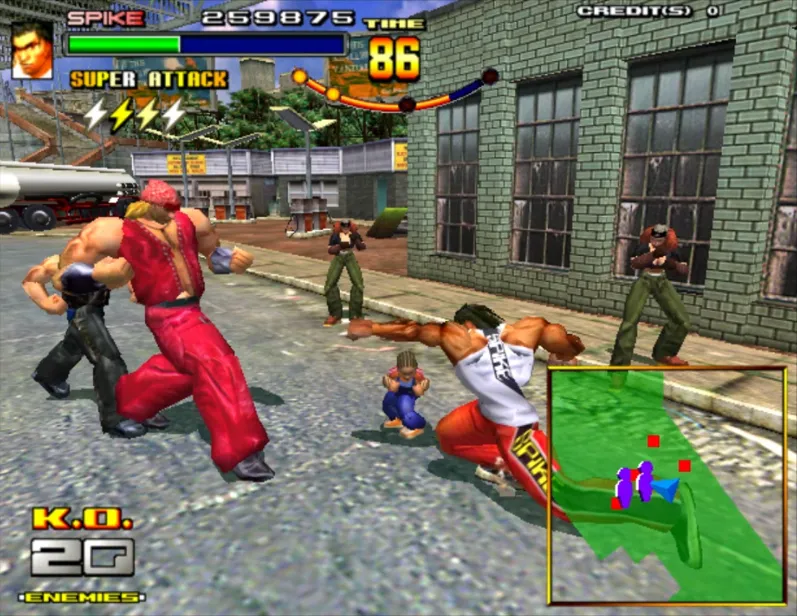
These can move and dodge hits if you don't get close enough, and many times if you try to attack them with basic hits, they will activate invincibility and hit or grab you. Dealing with them along with many other enemies is what makes this game quite difficult to beat without taking advantage of the free emulator credits, because you will die a lot even on the easiest difficulty. One explanation is that the game was designed for multiplayer of up to 4 players, and it might be easier to deal with them all with each one taking care of one side...but apparently the game doesn't adjust the amount of enemies much if you play solo, so in that case you're left with nothing but gritting your teeth and taking the hits while you practice.
For reference, I spent 17 minutes using savestates while practicing trying to beat the second level's first bosses without dying (yes, there are more), and so far this would be the only time I've technically beaten them without dying (technically because while I didn't use them in the middle of the fight, I would restart each time at the beginning of it instead of trying again from the beginning of the game).
On the other hand, my best game so far has been this one, where I got through the first level without a death on max difficulty (since at the time other more experienced players were telling me to practice with that one), but ended up losing to the bosses I just mentioned.
And while for a long time you couldn't, now with the emulator it's possible to play two to four players!
...Although it's complicated to set up, since it's practically having two emulators open with different controls configured, and in my case with three/four instances the game starts to slow down, so so far I've only been able to play it from start to finish with one other player. It's definitely entertaining, but with the lack of experience my cousin and I had for this (not to mention that the game only gets harder and harder than it already was when you keep playing) we died many times 🤠
So what else could I say about this game? That its 90s arcade essence emanates everywhere: The art style, the impacts and dynamic gameplay, the music and game vibes, the innovation by the hardware in the gameplay and multiplayer style...and the overwhelming difficulty that will take every last penny out of your pocket. And at the end of the day it takes just under two hours to complete from start to finish with the shortest route, but it really is one of those examples of pure fun with no pretensions or excuses to let you beat up thugs.
What else would give this game a special status is that it has never been ported directly to older or modern consoles, and while it received two more spinoffs on Arcade, the only home version of this game was Spikeout Battle Street for Xbox, which had most levels intact but with a new story and, unfortunately, a new coat of paint with fewer colors. But that will be a story to tell when I can emulate that version of the game 😎.

English translation with DeepL. All screenshots were captured by myself.
Español
Esto no lo sabrán muchos, pero mientras que la franquicia Yakuza de SEGA ha sido una de sus franquicias modernas más exitosas gracias a su historia y mundo combinado con un estilo de pelea beat-em-up en 3D, fanáticos mas acérrimos de SEGA conocerán que la experiencia detrás de ambos aspectos del juego tienen orígenes desde unos pocos años atrás.
Por una parte, Yu Suzuki ya había experimentado con un juego con un mundo explorable y enfocado en la historia junto con el ambiente, junto con un sistema de combate inspirado en Virtua Fighter (franquicia que el también creó y dirigió hasta la cuarta entrega). Este sería Shenmue.
Por otro lado, Toshihiro Nagoshi, quien trabajó con Yu Suzuki en varios juegos de carrera de arcade (como Daytona USA 2 y F-ZERO GX) y además fue el creador de Super Monkey Ball, también diseñó y produjo un juego de acción en 3D...solo que sería la contraparte con nada más que acción (a diferencia de exploración e historia con un poco de acción): SpikeOut.
...y 7 años después, produciría la primera entrega de Yakuza para PS2, en el cual combinó la idea de Suzuki con Shenmue y su historia con su propia experiencia con combates en 3D. Pero ya que aun tengo que experimentar alguno de los juegos apropiadamente, les vengo a hablar de ese predecesor lleno de adrenalina y golpes por doquier: SpikeOut Final Edition.

Para empezar, la diferencia principal entre "Final Edition" y el original "Digital Battle Online" es que este incluye un nuevo primer nivel (y el antiguo se juega después de completar este), y otro nivel adicional...pero fuera de eso no hay mucho documentado acerca de las diferencias más leves. Pero la mayoría que se interesa en Spikeout suele jugar Final Edition.
Ya con eso claro, este es un beat-em-up en 3D que recuerda a juegos como Streets of Rage, pero para su época (y hasta para hoy, si no contamos los Hack and Slash que asemejarían más lo que se hizo aquí) lo hacía de una forma bastante diferente: Los niveles estaban divididos en areas y varios de ellos no eran simples pasillos, sino lugares con obstáculos y hasta niveles de elevación (como estar en la planta baja de un centro comercial mientras que hay más enemigos arriba), y los controles también tenían su propio giro.

Además de tu botón obligatorio de golpe y de salto, tienes un botón para desplazarte a los lados sin girar de donde estas viendo (el cual sirve para esquivar enemigos si alguien viene corriendo hacia tí y no perder de vista a ciertos enemigos) y un botón de patadas que al mantener presionado se convierte en un ataque cargado mientras que la barra de carga aumenta. Tienes tres ataques cargados: Un ataque rápido para mandar a un enemigo al aire en nivel 1, un ataque que deja a tu enemigo aturdido con un golpe en el estómago en nivel 2, y un potente ataque en nivel 3. Para usar el ataque que quieras tienes que presionar y soltar en los momentos correctos para obtener el nivel deseado, y no lo puedes mantener cargado para siempre.
El juego te da varias opciones para defenderte y hasta para hacer combos...pero lo que hace este juego bastante difícil es que los enemigos aquí no tienen ni una pizca de piedad. Tendrás olas y olas de enemigos atacando desde todos lados (y a diferencia de beat-em-ups en 2D, como aquí solo golpeas a un enemigo a la vez con ataques básicos, no puedes usar un truco para derrotar a uno a punta de golpes ya que los otros pueden atacarte), y mientras que tienes un super ataque de área al presionar todos los botones (que tienen un costo) para quitarte multitudes de encima, los jefes son lo más difícil de todo.

Estos pueden moverse y esquivar golpes si no te acercas bien, y muchas veces si intentas atacarlos con golpes básicos, activaran invencibilidad y te golpearan o agarraran. Lidiar con ellos junto con muchos otros enemigos más es lo que hace este juego bastante difícil de superar sin aprovechar de los créditos gratis del emulador, porque morirás mucho aún en la dificultad más fácil. Una explicación es que el juego fue diseñado para multijugador de hasta 4 jugadores, y podría ser más fácil lidiar con todos con cada uno encargándose de un lado...pero al parecer el juego no ajusta mucho la cantidad de enemigos si juegas en solitario, así que en ese caso no te queda más que apretar los dientes y recibir los golpes mientras practicas.
Como referencia, pasé 17 minutos usando savestates mientras practicaba intentar ganarle a los primeros jefes del segundo nivel sin morir (porque sí, hay más), y hasta ahora esta sería la única vez en las que técnicamente les he ganado sin morir (técnicamente porque mientras que no los usé en medio de la pelea, reiniciaba cada vez al inicio de ella en vez de intentar de nuevo desde el principio del juego).
Por otra parte, mi mejor partida hasta ahora ha sido esta, en la que pasé el primer nivel sin una muerte en la máxima dificultad (ya que en ese entonces otros jugadores con más experiencia me decían que practicara con ese), pero terminé perdiendo contra los jefes que acabo de mencionar.
Y mientras que por mucho tiempo no se podía, ahora con el emulador es posible jugar de dos a cuatro jugadores!
...Aunque es complicado de configurar, ya que prácticamente es tener dos emuladores abiertos con controles diferentes configurados, y en mi caso con tres/cuatro instancias el juego empieza a ralentizarse, así que hasta ahora solo lo he podido jugar de principio a fin con otro jugador más. Definitivamente es entretenido, pero con la falta de experiencia que tenía mi primo y yo para esto (sin contar que el juego solo se pone más y más difícil de lo que ya era cuando sigues jugando) morimos muchas veces 🤠
Entonces que más podría decir de este juego? Que su esencia arcade de los 90s emana por todos lados: El estilo artístico, los impactos y jugabilidad dinámica, la música y vibras del juego, la innovación por el hardware en el estilo de juego y multijugador...y la abrumadora dificultad que te sacará hasta el último centavo del bolsillo. Y al final de cuentas dura poco menos de dos horas para completar de principio a fin con la ruta mas corta, pero realmente es uno de esos ejemplos de diversión pura sin pretensiones ni excusas para dejarte golpear a maleantes.
Lo que más daría un estatus especial a este juego es que nunca ha sido porteado directamente a consolas antiguas o modernas, y mientras que recibió dos spinoffs más en Arcade, la única versión casera de este juego fue Spikeout Battle Street para Xbox, el cual tenía la mayoría de niveles intactos pero con una historia nueva y, desafortunadamente, una nueva capa de pintura con menos colores. Pero eso será una historia que contar para cuando pueda emular esa versión del juego 😎

Traducción al inglés hecha con DeepL. Todas las fotos capturadas por mí.
